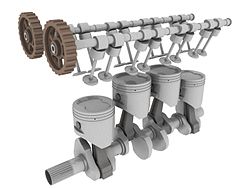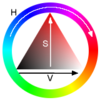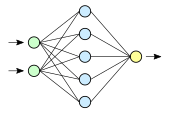Appendix:Glossary of machine vision
Appearance
Common definitions related to the machine vision field.
Compiled for application on the Society of Manufacturing Engineers interest area.
Related fields
| Contents: A B C D E F G H I J K L M N O P Q R S T U V W X Y Z |
0-9
[edit]- 1D. One dimensional.
- 2D computer graphics. The computer-based generation of digital images—mostly from two-dimensional models (such as 2D geometric models, text, and digital images) and by techniques specific to them.

- 3D scanner. This a device that analyzes a real-world object or environment to collect data on its shape and possibly color
A
[edit]- aperture. In photography or machine vision, aperture means the diameter of the aperture stop of a photographic lens. The aperture stop can be adjusted to control the amount of light reaching the film or image sensor.
- Aspect ratio. The aspect ratio of an image is its displayed width divided by its height (usually expressed as "x:y").
B
[edit]
- barcode. (Or bar code.) A machine-readable representation of information in a visual format on a surface.
- blob discovery. Inspecting an image for discrete blobs of connected pixels (e.g. a black hole in a grey object) as image landmarks. These blobs frequently represent optical targets for machining, robotic capture, or manufacturing failure.
- Bitmap. A raster graphics image, digital image, or bitmap, is a data file or structure representing a generally rectangular grid of pixels, or points of color, on a computer monitor, paper, or other display device.
C
[edit]- Camera. A device used to take pictures, either singly or in sequence. A camera that takes pictures singly is sometimes called a photo camera to distinguish it from a video camera.
- Charge-coupled device. A charge-coupled device (CCD) is a sensor for recording images, consisting of an integrated circuit containing an array of linked, or coupled, capacitors. CCD sensors and cameras tend to be more sensitive, less noisy, and more expensive than CMOS sensors and cameras.
- CMOS. Complementary metal-oxide semiconductor, a major class of integrated circuits. CMOS imaging sensors for machine vision are cheaper the CCD sensors but more noisy.
- Color. The perception of the frequency (or wavelength) of light, and can be compared to how pitch (or a musical note) is the perception of the frequency or wavelength of sound.
- Color blindness. Also known as color vision deficiency, in humans it is the inability to perceive differences between some or all colors that other people can distinguish
- Color temperature. "White light" is commonly described by its color temperature. A traditional incandescent light source's color temperature is determined by comparing its hue with a theoretical, heated black-body radiator. The lamp's color temperature is the temperature in kelvins at which the heated black-body radiator matches the hue of the lamp.
- computer vision. The study and application of methods which allow computers to "understand" image content or content of multidimensional data in general.
- Contrast. In visual perception, contrast is the difference in visual properties that makes an object (or its representation in an image) distinguishable from other objects and the background.
- C-Mount. Standardized adapter for optical lenses on CCD - cameras. C-Mount lenses have a back focal distance 17.5mm vs. 12.5mm for "CS-mount" lenses. A C-Mount lens can be used on a CS-Mount camera through the use of a 5mm extension adapter. C-mount is a 1" diameter, 32 threads per inch mounting thread (1"-32UN-2A.)
- CS-Mount. Same as C-Mount but the focal point is 5mm shorter. A CS-Mount lens will not work on a C-Mount camera. CS-mount is a 1" diameter, 32 threads per inch mounting thread.
D
[edit]
- data matrix. A two dimensional barcode.
- depth of field. In optics, particularly photography and machine vision, the depth of field (DOF) is the distance in front of and behind the subject which appears to be in focus.
- Diaphragm. In optics, a diaphragm is a thin opaque structure with an opening (aperture) at its centre. The role of the diaphragm is to stop the passage of light, except for the light passing through the aperture.
E
[edit]- edge detection. ED marks the points in a digital image at which the luminous intensity changes sharply.
- electromagnetic interference. Radio Frequency Interference (RFI) is electromagnetic radiation which is emitted by electrical circuits carrying rapidly changing signals, as a by-product of their normal operation, and which causes unwanted signals (interference or noise) to be induced in other circuits.
F
[edit]- FireWire. FireWire (also known as i. Link or IEEE 1394) is a personal computer (and digital audio/video) serial bus interface standard, offering high-speed communications. It is often used as an interface for industrial cameras.
- Frame grabber. A frame grabber is a component of a computer system designed for digitizing analog and digital video signals
- Field of view. The field of view (FOV) is the part which can be seen by the machine vision system at one moment. The field of view depends from the lens of the system and from the working distance between object and camera.
- Focus. An image, or image point or region, is said to be in focus if light from object points is converged about as well as possible in the image; conversely, it is out of focus is light is not well converged. The border between these conditions is sometimes defined via a circle of confusion criterion.
G
[edit]- Grayscale. A grayscale digital image is an image in which the value of each pixel is a single sample. Displayed images of this sort are typically composed of shades of gray, varying from black at the weakest intensity to white at the strongest, though in principle the samples could be displayed as shades of any color, or even coded with various colors for different intensities.
- GUI (sometimes pronounced "gooey"). A graphical user interface, a method of interacting with a computer through a metaphor of direct manipulation of graphical images and widgets in addition to text.
H
[edit]
- HSV color space.The HSV (Hue, Saturation, Value) model, also called HSB (Hue, Saturation, Brightness), defines a color space in terms of three constituent components:
- Hue, the color type (such as red, blue, or yellow)
- Saturation, the "vibrancy" of the color and colorimetric purity
- Value, the brightness of the color
I
[edit]
- incandescent lightbulb. An incandescent lightbulb generates light using a glowing filament heated to white-hot by an electrical current.
J
[edit]- JPEG. JPEG (pronounced jay-peg) is a most commonly used standard method of lossy compression for photographic images.
K
[edit]N/A
L
[edit]- Lens. A lens is a device that causes light to either converge and concentrate or to diverge, usually formed from a piece of shaped glass. Lenses may be combined to form more complex optical systems as a normal lens or a telephoto lens.
- Lighting. Lighting refers to either artificial light sources such as lamps or to natural illumination. Choosing the accurate lighting for a machine vision system needs lot of experience.
M
[edit]- machine vision. (MV) is the application of computer vision to industry and manufacturing.
- metrology. The science of measurement. There are lots of applications for machine vision in metrology.
N
[edit]
- neural network (NN). An interconnected group of artificial neurons that uses a mathematical or computational model for information processing based on a connectionist approach to computation. In most cases an ANN is an adaptive system that changes its structure based on external or internal information that flows through the network.
- normal lens. In machine vision a normal or entrocentric lens is a lens that generates images that are generally held to have a "natural" perspective ( nearer objects appear larger, and farther objects smaller) compared with lenses with longer or shorter focal lengths. Lenses of shorter focal length are called wide-angle lenses, while longer focal length lenses are called telephoto lenses.
O
[edit]- optical character recognition. Usually abbreviated to OCR, involves computer software designed to translate images of typewritten text (usually captured by a scanner) into machine-editable text, or to translate pictures of characters into a standard encoding scheme representing them in (ASCII or Unicode).
P
[edit]
- pattern recognition. A field within the area of machine learning. Alternatively, it can be defined as the act of taking in raw data and taking an action based on the category of the data. It is a collection of methods for supervised learning.
- pixel. One of the many tiny dots that make up the representation of a picture in a computer's memory or screen.
- pixelation. In computer graphics, pixelation is an effect caused by displaying a bitmap or a section of a bitmap at such a large size that individual pixels, small single-colored square display elements that comprise the bitmap, are visible to the eye.
- prime lens. Mechanical assembly of lenses whose focal length is fixed, as opposed to a zoom lens, which has a variable focal length.
Q
[edit]N/A
R
[edit]
- RGB. The RGB color model utilizes the additive model in which red, green, and blue light are combined in various ways to create other colors.
S
[edit]- Shutter. A shutter is a device that allows light to pass for a determined period of time, for the purpose of exposing the image sensor to the right amount of light to create a permanent image of a view.
- shutter speed. In machine vision the shutter speed is the time for which the shutter is held open during the taking an image to allow light to reach the imaging sensor. In combination with variation of the lens aperture, this regulates how much light the imaging sensor in a digital camera will receive.
- smart camera. An integrated machine vision system which, in addition to image capture circuitry, includes a processor, which can extract information from images without need for an external processing unit, and interface devices used to make results available to other devices.
- SVGA. Super Video Graphics Array, almost always abbreviated Super VGA or just SVGA, is a broad term that covers a wide range of computer display standards.
T
[edit]- telecentric lens. Compound lens with an unusual property concerning its geometry of image-forming rays. In machine vision systems telecentric lenses are usually employed in order to achieve dimensional and geometric invariance of images within a range of different distances from the lens and across the whole field of view.
- telephoto lens. Lens whose focal length is significantly longer than the focal length of a normal lens.
- thermography. Thermal imaging, a type of infrared imaging.
- TIFF. Tagged Image File Format, a file format for mainly storing images, including photographs and line art.
U
[edit]- USB. Universal Serial Bus (USB) provides a serial bus standard for connecting devices, usually to computers such as PCs , but is also becoming commonplace on cameras.
V
[edit]- VGA. Video Graphics Array (VGA) is a computer display standard first marketed in 1987 by IBM
W
[edit]
- wide-angle lens. In photography and cinematography, a wide-angle lens is a lens whose focal length is shorter than the focal length of a normal lens.
X
[edit]
- X-ray. A form of electromagnetic radiation with a wavelength in the range of 10 to 0.01 nanometer, corresponding to frequencies in of 30 to 3000 PHz (petahertz). X-rays are primarily used for diagnostic medical and industrial imaging as well as crystallography. X-rays are a form of ionizing radiation and so can be dangerous.
Y
[edit]N/A
Z
[edit]
- Zoom lens. A mechanical assembly of lenses whose focal length can be changed, as opposed to a prime lens, which has a fixed focal length.
Further reading
[edit]Other machine vision online glossary repositories:
- Image Labs International's Glossary
- Navitar Glossary of Terms
- RoboRealm Machine Vision Glossary
- MachineVisionOnline.org Glossary
- Prosilica Glossary of Terms
- Visionary: A dictionary for the study of vision
General resources
- The Computer Vision Homepage
- Keith Price's Annotated Computer Vision Bibliography
- British Machine Vision Association
- European Machine Vision Association
- Machine Vision Online
Computer Vision Laboratories
- Oak Ridge National Laboratory Image Science & Machine Vision Group
- ETH Zürich Computer Vision Laboratory
- MMVL MediaWiki
- Kingston University's Digital Imaging Research Centre (DIRC)
- Probilistic and Statistical Inference Group @ University of Toronto
Tutorials
- On-Line Compendium of Computer Vision
- Tutorial to Image Processing
- Introduction to computer vision (464KB pdf file)
- iKnow Vision interactive tutorial
Papers
